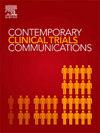干针对跆拳道运动员股四头肌疲劳的影响:一项三盲随机对照试验的协议
IF 1.4
Q4 MEDICINE, RESEARCH & EXPERIMENTAL
引用次数: 0
摘要
运动员的一个共同问题是肌肉疲劳,在进行肌肉活动后,骨骼肌力量的潜力会短暂而短暂地下降。目前缺乏高质量的临床研究来评估干针(DN)对运动员肌肉疲劳的影响。因此,本研究旨在探讨DN对跆拳道运动员股四头肌疲劳的影响。方法采用三盲、随机、对照试验,观察DN后股四头肌疲劳的变化。88名符合资格标准的跆拳道运动员将在运动后接受DN或假针刺四头肌。在运动前、运动疲劳后和干预后进行三项评估。测量结果将是等距峰值扭矩,单腿跳跃测试和垂直跳跃测试。结论本研究结果将为DN改善跆拳道运动员股四头肌疲劳的有效性提供初步证据。registrationIRCT20210811052141N1审判。本文章由计算机程序翻译,如有差异,请以英文原文为准。
Effect of dry needling on quadriceps muscles fatigue in taekwondo players: A protocol for a triple-blinded randomized controlled trial
Background
A common issue among athletes is muscle fatigue, a brief and transient reduction in the potential of skeletal muscle strength after engaging in muscular activity. A high-quality clinical investigation to evaluate the impact of dry needling (DN) on athletes’ muscle fatigue is lacking. Therefore, this study aims to examine the effect of DN on quadriceps muscle fatigue in taekwondo players.
Methods
A triple-blind, randomized, controlled trial will be conducted to measure changes in quadriceps muscle fatigue after DN. Eighty-eight taekwondo players who meet the eligibility criteria will be selected to receive either DN or sham needling to the quadriceps muscle after exercise. Three assessments will be performed before the exercise, after exercise fatigue, and after intervention. The outcomes measured will be isometric peak torque, single-leg hop test, and vertical jump test.
Conclusions
The results of this study will provide preliminary evidence regarding the effectiveness of DN in improving quadriceps muscle fatigue in taekwondo players.
Trial registration
IRCT20210811052141N1.
求助全文
通过发布文献求助,成功后即可免费获取论文全文。
去求助
来源期刊

Contemporary Clinical Trials Communications
Pharmacology, Toxicology and Pharmaceutics-Pharmacology
CiteScore
2.70
自引率
6.70%
发文量
146
审稿时长
20 weeks
期刊介绍:
Contemporary Clinical Trials Communications is an international peer reviewed open access journal that publishes articles pertaining to all aspects of clinical trials, including, but not limited to, design, conduct, analysis, regulation and ethics. Manuscripts submitted should appeal to a readership drawn from a wide range of disciplines including medicine, life science, pharmaceutical science, biostatistics, epidemiology, computer science, management science, behavioral science, and bioethics. Contemporary Clinical Trials Communications is unique in that it is outside the confines of disease specifications, and it strives to increase the transparency of medical research and reduce publication bias by publishing scientifically valid original research findings irrespective of their perceived importance, significance or impact. Both randomized and non-randomized trials are within the scope of the Journal. Some common topics include trial design rationale and methods, operational methodologies and challenges, and positive and negative trial results. In addition to original research, the Journal also welcomes other types of communications including, but are not limited to, methodology reviews, perspectives and discussions. Through timely dissemination of advances in clinical trials, the goal of Contemporary Clinical Trials Communications is to serve as a platform to enhance the communication and collaboration within the global clinical trials community that ultimately advances this field of research for the benefit of patients.
 求助内容:
求助内容: 应助结果提醒方式:
应助结果提醒方式:


